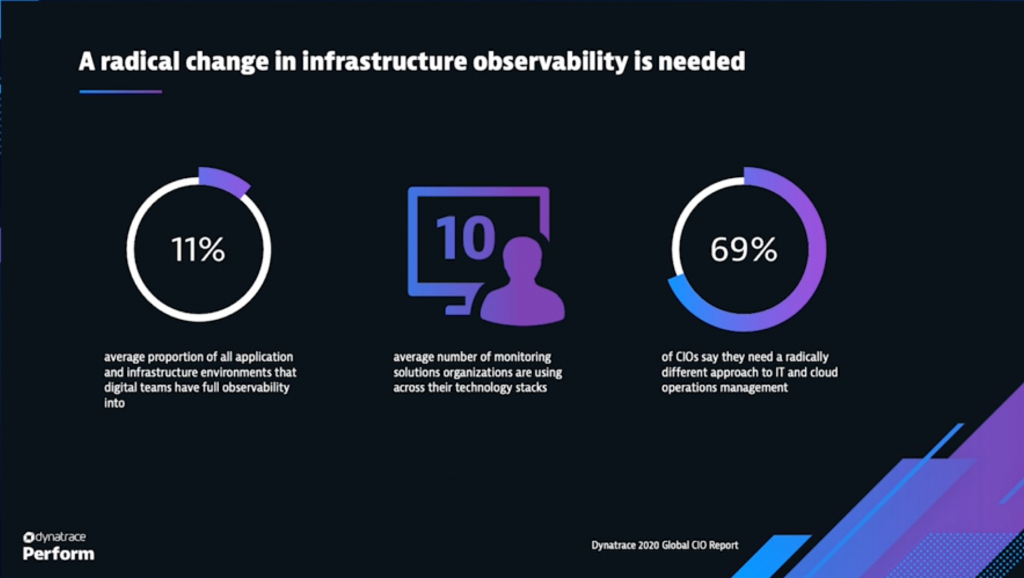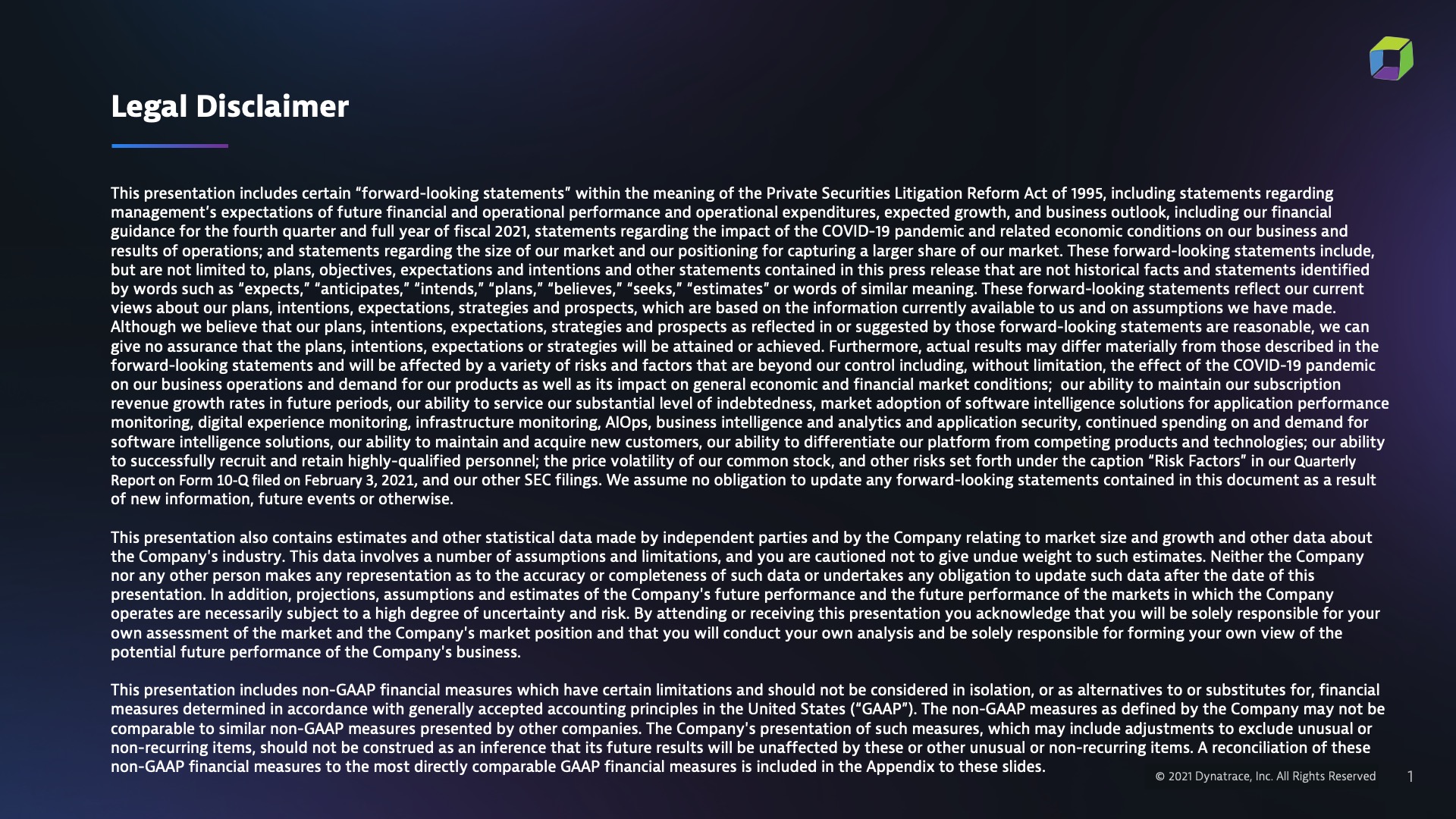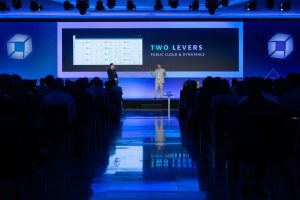Manual infrastructure monitoring can't keep pace across increasingly complex environments. The solution? Complete observability with advanced AIOps.
Infrastructure complexity is costing enterprises money. According to the Dynatrace 2020 Global CIO Report, companies now spend an average of $4.8 million per year just “keeping the lights on,” with 63% of CIOs surveyed across five continents calling out complexity as their biggest barrier to controlling costs and improving efficiency.
AIOps offers an alternative to traditional infrastructure monitoring and management with end-to-end visibility and observability into IT stacks. At Perform 2021, I was joined by Michael Kopp, Dynatrace’s Director of Product Management, to talk about current infrastructure challenges, critical operational needs, and the advantages of agile, adaptable AIOps.
Blind spots emerge in complex environments
Keeping the lights on takes effort and time — both of which organizations could put to better use elsewhere. But increasing complexity and lacking visibility creates a problem: Enterprises invest more resources into monitoring and don’t get the data and answers they need. In fact, Dynatrace survey data found that organizations have total visibility into just 11% of all applications and infrastructure, despite using an average of 10 monitoring tools for the job.

As 69% of CIOs surveyed said, it’s time for a “radically different approach” to infrastructure monitoring. Of course, it’s one thing to recognize business IT blind spots; it’s another to effectively address these issues at scale. AIOps can help.
AI powers cloud visibility
To enable infrastructure observability, companies need “platforms built for highly dynamic cloud environments that offer broad technology coverage for both multi-cloud and legacy technologies across multiple use cases.”
Current monitoring tools are frequently point solutions. Despite best efforts, they’re naturally limited to segments of infrastructure stacks causing blind spots and disparate data. Meanwhile, modern observability platforms and artificial intelligence operations (AIOps) make it possible to bridge this gap and provide full observability and advanced analytics across the technology stack — whether on-premises, in the cloud or anywhere in-between.
Dynatrace and Davis AI deliver on this potential, powering a single, consistent, coherent platform to deliver AIOps for infrastructure monitoring. Customers say that the Dynatrace solution is “transforming the way they work” by offering advantages in three key areas:
- Time: By automating key operations, enterprise IT teams gain time for innovation.
- Quality: Fewer staff and resources are spent on manual data collection, and reporting improves focus on customer value and quality.
- Collaboration: With a “single source of truth,” teams are better equipped to collaborate flexibly as needed.
AIOps tames container complexity
Consider this: 92% of companies use containers as part of production, but 41% see containers adding complexity to their infrastructure monitoring operations.

To help address this issue, Dynatrace designed the first-ever AIOps solution for Kubernetes, which works across any managed or native Kubernetes environment to offer unified visibility across different use cases. For example, application development teams might use distributed tracing and full-stack observability to improve app performance, while cloud operations teams focus on log and event analysis to optimize health and resource utilization of clusters, nodes, and pods. As both teams rely on their optimized views, they are using the same underlying logs and metrics together in context, and can therefore easily compare notes and collaborate when needed without having to do independent correlation. Best of all, the AI can automatically trace problems from the front-end to the infrastructure and vice versa.
The value of 360-degree visibility
Guessing isn’t good for business. End-to-end observability paves the way to effectively link infrastructure health and performance to customer experience and business outcomes.
This is the value of AIOps: automation to extend and improve observability in highly dynamic environments with the goal of a single source of truth coupled with purpose-built AI to visualize, analyze, and operate traditional and cloud-native IT stacks. But what does this mean in practice? Michael put it simply: “Companies need to get the data and make sense of the data.”
Dynatrace’s Davis AI helps organizations achieve this goal by mapping all observability data (metrics, traces, logs, events, real user data) to the system topology in real-time to understand the causal relationship between customer experience and business outcomes, and infrastructure and application performance.

The result is 360-degree visibility that solves four key infrastructure operations requirements:
1. End-to-end observability
Because modern environments are built in hybrid environments, including public and private clouds and traditional infrastructure, Dynatrace supports more than 500 technologies, integrations, and extensions out of the box and is continually evolving to support new technologies at enterprise scale.
2. Automatic impact analysis
Davis AI can automatically determine the severity of an infrastructure problem in terms of real user impact and business KPIs, like shopping cart volumes or sales volume. This tells DevOps teams which problems to prioritize and helps organizations invest in the right infrastructure to maximize the benefits of their digital transformation.
3. Root-cause analysis
While solving for symptoms can address immediate issues, surface-level responses and workarounds often prolong infrastructure problems. In contrast, by automatically processing billions of causal dependencies in near real-time, Davis is capable of identifying the true root cause of a breakdown. Eliminating dreaded war-room Davis lays the groundwork for fast problem-solving and continuous improvements.
4. Actionable insight
By leveraging high-fidelity infrastructure data, Davis’ deterministic AI offers such precise and reliable answers that autonomous operations becomes possible. Some of the most advanced Dynatrace customers are using Davis to trigger auto-remediation workflows, including deployment rollbacks and auto-scaling. Others are using Davis for Customer Relationship Management (CRM) to automatically rectify bad customer experiences.
The bottom line is that simply keeping the lights on isn’t enough. Complete observability is now critical for managing complex infrastructure environments. Today’s forward-thinking leaders know this and are adopting the AIOps approach to streamline the development and delivery of tomorrow’s top software solutions.
Check out the full session below to learn more about what Dynatrace and Davis can do to deliver the AIOps advantage to your organization.





Looking for answers?
Start a new discussion or ask for help in our Q&A forum.
Go to forum